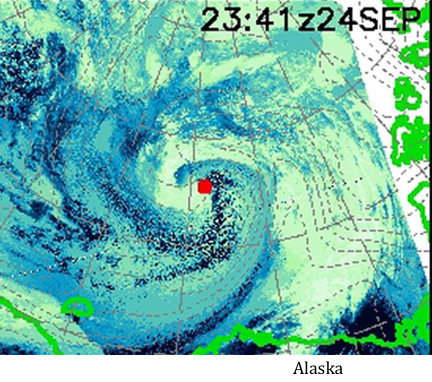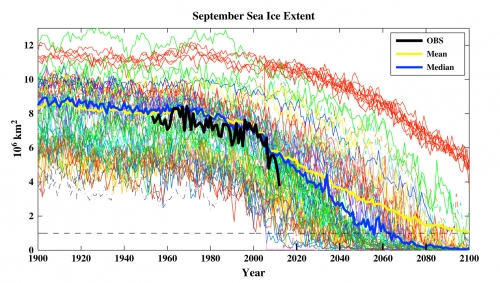Prediction of when the Arctic Ocean will be nearly ice-free in summer is of interest to arctic and non-arctic science and resource management communities, since large shifts in the arctic environment represent indicators of global climate change. National Oceanic and Atmospheric Administration (NOAA) scientist James Overland, of NOAA's Pacific Marine Environmental Laboratory, and Muyin Wang, of the NOAA Joint Institute for the Study of Atmosphere and Ocean at the University of Washington, recently investigated a range of methods for predicting future sea ice loss and identified three groups of approaches: extrapolation of sea ice volume, analysis of rapid sea ice loss events due to ocean and weather conditions, and climate model results. They found each approach had strengths and weaknesses, but indicated nearly ice-free summers in the Arctic Ocean before the middle of the 21st century with a possibility of major loss within a decade or two—significantly earlier than previously accepted predictions.
Overland and Wang named the three predictive approaches trendsetters, stochasters, and modelers. Trendsetters analyzed observed sea ice trends. Overland and Wang confirmed the work of others—that sea ice volume is decreasing at a faster rate than sea ice extent, and conclude that ice volume is the better variable to use for predictions (see Figure 1). Data show that the total amount of sea ice has decreased rapidly since 2004, and the Arctic has lost 75% of its sea ice volume since the 1980s. Using those trends, this approach extrapolates to a nearly sea ice-free Arctic by 2020.

Stochasters assumed future multiple, but random in time, large sea ice loss events such as those that occurred in 2007 and 2012 (see Figure 2). This method estimates it would take several more of these events to reach the 1.0 million square kilometer sea ice extent threshold of a nearly sea ice-free state in the summer. Using the likelihood of such events, this approach suggests a nearly sea ice-free Arctic by about 2030 but with large uncertainty in timing.

Modelers used the large collection of global climate model (GCM) results to predict changes in sea ice conditions over time. GCMs are important quantitative tools to predict future climate projections based on physical laws and processes of the atmosphere, ocean, land, and sea ice. The median timing of sea ice loss in these models is close to 2060 (see Figure 3). The earliest possible loss of sea ice is projected to be around 2040 as greenhouse gas concentrations increase and the Arctic warms. But the observed rapid loss of thick, multi-year sea ice over the last decade and the September 2012 arctic sea ice extent reduction of 49% relative to the 1979-2000 climatology are inconsistent with GCM-based projections. There are several reasons to consider that median timing of sea ice loss in GCM based models may be too slow. Uncertainties introduced by parameterizations of clouds in different models and atmospheric dynamics may be more of a difficulty than modeling sea ice.

Indications are that the present and projected carbon dioxide loading will continue the climate forcing on the Arctic over the next several decades. CO2 has increased 25% since 1970 and has just passed 400 ppm. Multiple feedback processes referred to as "arctic amplification" increase the impact from this external forcing but also add to the uncertainly in predictions.
Available evidence suggests that scientists have been conservative in their projections of climate change with a bias of late dates for change. The range among the multiple approaches suggests that it is very likely that the timing for future sea ice loss will be within the first half of the 21st century, with a possibility of major loss within a decade or two. According to Overland there is a great need for improved models, annual tracking of arctic changes, and planning the response to broader arctic changes.
A full report of this study, entitled "When will the Summer Arctic be Nearly Sea Ice Free?" was published in March 2013 in Geophysical Research Letters.
For further information, please see the NOAA press release or contact James Overland (james.e.overland [at] noaa.gov).
